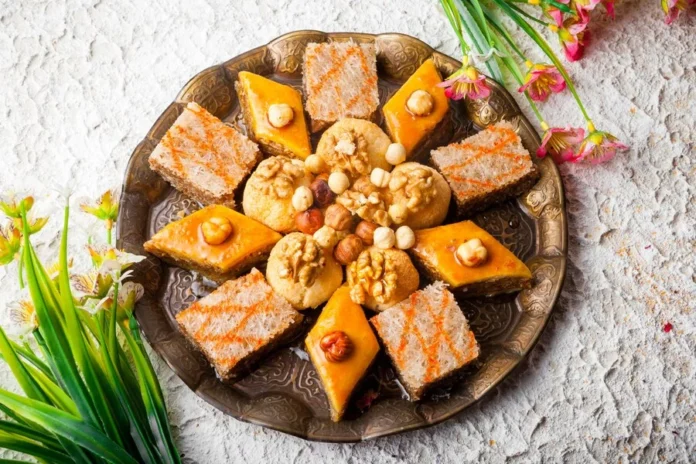Gujarat, a dynamic state in western India, is eminent for its rich social legacy, colorful celebrations, and luscious food.
The sweet dishes hold an extraordinary place among the many flavors that beautify the Gujarati sense of taste.
In this article, we will explore delightful journey into the world of Gujarati sweet dishes, investigating their unique ingredients, preparation methods, and the social centrality they carry.
Lets’s Explore some of the Gujarati Sweet Dishes Names
Gujarati Sweet Dishe Mohanthal: A Conventional Favorite

Mohanthal, an adored sweet dish in Gujarat, could be a classic among Gujarati family units. Made from gram flour (besan), ghee, and sugar, this fudgy dessert is regularly embellished with chopped almonds or pistachios.
The particular taste of Mohanthal is inferred from the cautious broiling of besan in ghee, conferring a nutty flavor that waits on the taste buds.
This sweet treat differs from what it was delighted in amid celebrations like Diwali but is also a well-known choice for festivals and extraordinary events.
Gujarati Sweet Dish Basundi: The Rich Remedy of Gujarat
Basundi, a rich and delectable dessert, could be a staple in Gujarati family units. Arranged by stewing drain until it thickens, Basundi is sweetened with sugar, flavored with cardamom, and garnished with chopped nuts.
It is regularly served chilled, making it a reviving liberality, especially during the searing summer months. Basundi isn’t as it was savored as a standalone dessert but is additionally a key fixing within the celebrated Gujarati sweet dish, ‘Dudh Poha.’
Dudh Poha: A Ensemble of Flavors
Dudh Poha could be a unique and delightful sweet dish that combines the goodness of smoothed rice (poha) and the lavishness of Basundi. The poha is doused in drain and sugar, imbued with cardamom, and then topped with nuts and raisins.
The result could be a concordant mix of surfaces and flavors – the poha’s delicacy, which differentiates with the creamy Basundi, making a dish that captures the quintessence of Gujarati culinary imaginativeness.
Ghevar: A Happy Event
Ghevar, an outwardly dazzling sweet dish, takes center arrangement amid celebrations and celebrations in Gujarat. This complex dessert is made from a player of deep-fried flour, drain, and ghee to attain a latticed, honeycomb-like structure.
Ghevar is, at that point, doused in sugar syrup, giving sweetness to each layer. Decorated with fragments of almonds and pistachios, Ghevar isn’t only a treat for the taste buds, but a devour for the eyes.
Doodh Pak: The Comforting Rice Pudding
Doodh Pak, a variation of the omnipresent rice pudding, holds a unique put in Gujarati cooking. Made with fragrant Basmati rice, drain, and sugar, Doodh Pak is prepared with cardamom and decorated with nuts.
This comforting dessert is frequently arranged amid favorable events and happy celebrations, symbolizing thriving and plenitude.
Suji Halwa: A Basic, However Fulfilling, Enchant
Suji Halwa, or Sheera or Kesari, could be a flexible and quick-to-make sweet dish delightful all over India, including Gujarat.
In this Gujarati form, semolina (suji) is simmered in ghee until brilliant brown, sweetened with sugar, and flavored with cardamom. This soul-soothing dessert is frequently arranged amid devout ceremonies.
It maybe a prevalent choice for breakfast or as a straightforward dessert after a savory dinner.
Kansar: A Symbol of Fellowship
Kansar could be a special sweet dish with profound cultural roots in Gujarat. It is customarily arranged amid promising events and devout ceremonies.
Most fixings incorporate the entirety of wheat flour, ghee, and jaggery. The planning of Kansar includes a beautiful custom called “Saakar Langa,” where the hitched ladies of the family come together to work the batter, symbolizing solidarity and harmony.
Conclusion:
Gujarati sweet dishes are not only culinary delights but also they are part of the celebrations, and familial bonds.
From the fudgy goodness of Mohanthal to the expanded tastefulness of Ghevar, each sweet dish reflects the artistry and warmth of Gujarati neighborliness.
As we savor these sweet treats, we enjoy our taste buds and share in a social involvement that rises above the boundaries of time, interfacing us with the wealthy legacy of Gujarat.
Several well-known examples are Mohanthal, Basundi, Ghevar, Dudh Poha, Doodh Pak, Suji Halwa, and Kansar.
Religious ceremonies, festivals, and special occasions are all occasions to indulge in these nostalgic sweets.
Because gramme flour (besan) is roasted in ghee,that’s why Mohanthal has a distinctively nutty flavour.
Batter is deep-fried and then soaked in sugar syrup to create the festive dessert known as ghevar. It’s well-liked on festive occasions.
Indeed, their popularity is evident in the fact that many Indian shops sell a range of Gujarati sweets outside the state.
Certainly, you can make a lot of Gujarati desserts at home with easily found ingredients.



